Molloy
Environmental
WTC Debris?
Tests & Bulletins
Masks & Suits
| Molloy
Environmental |
What's
in WTC Debris? |
Clean Your Home and Office | Your Air Conditioner Can Protect You | Environmental Tests & Bulletins |
| Health Effects of WTC Toxins | Protective Masks & Suits |
|
How to Rid Your Home and Office
of World Trade Center Dust |
|
***When
cleaning, be sure to wear
the appropriate mask and filter and disposable Tyvek suit.*** |
|
Step 1 - Vacuum
Twice with a HEPA Filter This will remove much of the dust without spreading it to other surfaces. Vacuums without a HEPA filter release fine particles of contaminated dust into the air. Step 2 - Damp
Mop and Damp Wipe Damp mopping can spread the dust to other surfaces. Be aware that
the WTC dust can stain some fabrics and surfaces. Step 3 - Be
Sure You're Safe - Testing and Clearance NOTES: Different Cleaning
Methods for Different Surfaces and Fabrics |